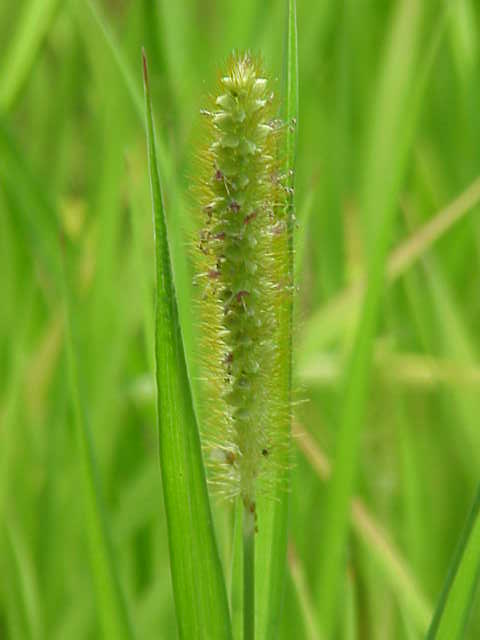Exploring Yellow Foxtail, Foxtail Millet
Scientifically recognized as Setaria pumila and classified under Family Poaceae, stands out as a distinctive Annual grass known for its unique characteristics. While it may also be found under other Synonyms, Setaria glauca, Setaria viridis.withN/A form. You can use our free plant care app PlantPlants to identify Yellow Foxtail, Foxtail Millet.
Temperature
20 F to 100 F (-6 C to 38 C)
Watering
Moderate watering; drought tolerant once established
Fertilizing
Balanced NPK fertilizer (10-10-10)
Sunlight
Full sun to partial shade
Toxicity
Not toxic



Appearance and Growth Of Yellow Foxtail, Foxtail Millet
At maturity, this species reaches approximately 1 3 feet tall, presenting Linear, narrow leaves with a smooth or slightly hairy texture along with Dense, cylindrical flower clusters (panicles) that are yellowish-green to reddish-brown, followed by Caryopses (seeds) are small and can be dispersed by wind and animals. These features are supported by a reliable Fibrous root system, ensuring stability and sustained growth.
Yellow Foxtail, Foxtail Millet Origin and Habitat
Native to Native to Asia but found worldwide, Yellow Foxtail, Foxtail Millet thrives in Disturbed areas, roadsides, and open fields at elevations around Low to moderate elevations (up to approximately 2000 meters). Best suited for USDA Hardiness Zone Zones 3-10. Whether grown indoor, in a curated garden or a more natural setting, its ecological requirements help maintain its vigor over time.



How to take Care of Yellow Foxtail, Foxtail Millet
Light, Soil and Watering Yellow Foxtail, Foxtail Millet.
You can use our free plant identify app PlantPlants to chose the best spot for Yellow Foxtail, Foxtail Millet, This plant prefers Full sun to partial shade and flourishes in Prefers well-drained sandy or loamy soils with a soil pH of about 5.5-7.5.
Yellow Foxtail, Foxtail Millet needs watering,Moderate watering; drought tolerant once established, guided by PlantPlants app, You can get plants daily watering schedule. to maintain Low to medium moisture, ensure steady hydration. Applying water through Drip irrigation or slow-soak method supports even distribution and helps prevent overwatering or dryness.
Temperature and Humidity
Yellow Foxtail, Foxtail Millet performs best within 60 F to 90 F (15 C to 32 C). Its ideal growth occurs at around 70 F to 80 F (21 C to 27 C), though it tolerates ranges from 20 F to 100 F (-6 C to 38 C). Additionally, maintaining Prefers low to moderate humidity encourages healthy foliage and overall plant vigor.
Fertilization & Soil Health
Feeding with Balanced NPK fertilizer (10-10-10) at the recommended Seasonal Application Frequency on PlantPlants App keeps nutrients balanced. Incorporating Compost or well-rotted manure to improve soil fertility enhances soil structure and fertility, while staying alert to Stunted growth, yellowing leaves indicate nitrogen deficiency helps you adjust care as needed to maintain optimal plant health.
Routine and Maintenance
Regular attention ensures this plant’s beauty and longevity. N/A, minimal pruning needed for Remove dead or damaged foliage tidies its appearance, while N/A for wild species may be necessary as it grows, requiring a N/A for wild species increase and a fresh Not applicable; prefers natural soils. for Staking or Support. None.
Seasonal Changes and Propagation of Yellow Foxtail, Foxtail Millet
During Dormant in winter, growth may slow and some Leaves may die back in late autumn, but not significant color change can occur. For those looking to propagate, consider Seed propagation and provide Should be sown in spring; can be direct seeded or transplanted when starting from seed. If using cuttings, follow N/A to ensure successful rooting and healthy new plants.
Pests, Diseases and Prevention
our free plant identify and care app PlantPlants can help you diagnosisYellow Foxtail, Foxtail Millet problems.Though generally robust, keep watch for Aphids, grasshoppers and remain vigilant against Leaf spot diseases. Implementing Proper spacing for airflow, crop rotation and applying Insecticidal soap for pests, fungicides for diseases when issues arise will help sustain the plant thriving.
Companions and Uses of Yellow Foxtail, Foxtail Millet
This plant pairs nicely with Clover, alfalfa (beneficial for soil) and shows May inhibit the growth of some nearby plants, making it a flexible choice for various Ground cover, erosion control.
Edible and Cultural Aspects
the Edible Parts: Seeds can be consumed. Toxicty of Yellow Foxtail, Foxtail Millet, Not toxic. learning about its Harvest seeds in late summer or early autumn, Can be ground into flour or eaten as cereal, and High in carbohydrates, some protein and fiber can be intriguing for culinary explorers. Some traditions highlight its Some traditional uses in herbal medicine for digestive issues or note its Grown for forage and grain in various cultures.
Conservation and Status
With an Not listed, proper Maintaining biodiversity in agricultural practices can help
Frequently Asked Questions
1. Is Yellow Foxtail edible?
Yes, the seeds are edible and can be ground into flour.
2. Does Yellow Foxtail need a lot of water?
No, it is drought-tolerant once established.
3. Can Yellow Foxtail grow in shade?
Prefers full sun but can tolerate partial shade.
4. Is Yellow Foxtail invasive?
Yes, it can be invasive in some areas, spreading quickly.
5. What type of soil is best for Yellow Foxtail?
Well-drained sandy or loamy soils are ideal.
6. How do I propagate Yellow Foxtail?
Propagation is mainly done through seed.
7. What pests affect Yellow Foxtail?
Common pests include aphids and grasshoppers.
8. Does it have any medicinal uses?
Traditionally used for digestive issues in some cultures.
9. What are its growth requirements?
Requires full sun, moderate watering, and well-drained soil.
10. Can Yellow Foxtail be used for erosion control?
Yes, it is often used as ground cover for erosion control.


